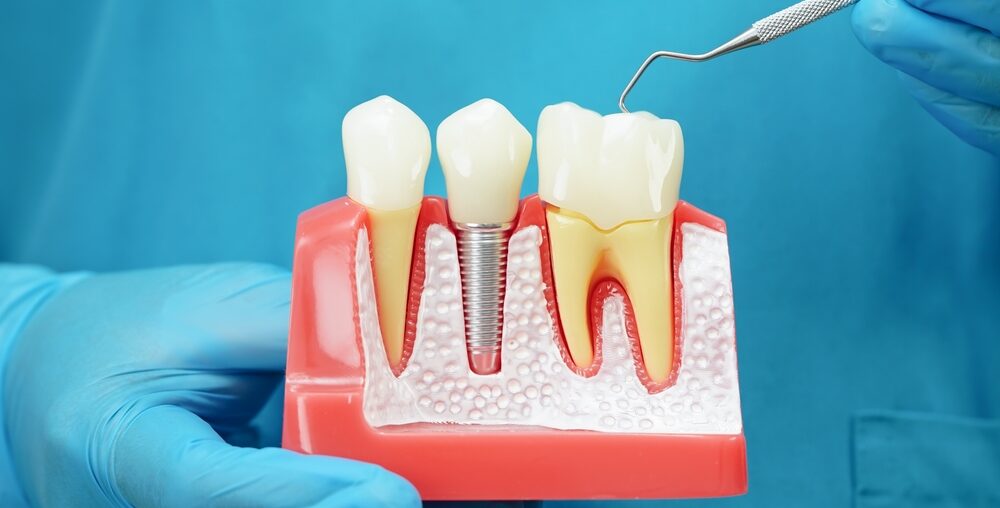Dental implants are a popular and effective solution for replacing missing teeth, offering both aesthetic and functional benefits. Whether you’re missing a single tooth or several, dental implants can provide a natural-looking and durable alternative to dentures or bridges. But are they the right choice for you? In this blog post, we’ll explore the benefits of dental implants, the procedure, recovery tips, potential complications, and aftercare. By the end, you’ll have a better understanding of whether dental implants might be the solution you’ve been searching for.
Why You Might Need a Tooth Extraction
Tooth extraction is often the first step before dental implants can be placed. There are several reasons why a tooth may need to be extracted, including:
- Severe Decay or Infection: When a tooth becomes extensively decayed or infected, and a root canal isn’t enough to save it, extraction may be necessary.
- Periodontal Disease: Advanced gum disease can lead to the loosening of teeth, requiring removal to prevent further damage.
- Trauma or Injury: A tooth that has been broken or damaged beyond repair due to an accident might need to be extracted.
- Overcrowding: In some cases, a tooth may be removed to make space for orthodontic treatment.
Once the tooth has been extracted, a dental implant can be placed to restore the function and appearance of the missing tooth.
The Dental Implant Procedure
The dental implant process typically involves several steps. While it can vary slightly depending on individual circumstances, the overall procedure remains relatively consistent.
Step 1: Consultation and Planning
Before any work begins, you’ll have a consultation with a dentist in NW Calgary. During this appointment, your dentist will take X-rays and potentially a 3D scan to assess the health of your gums and jawbone. This helps ensure that you’re a good candidate for dental implants and allows the dentist to create a personalized treatment plan.
Step 2: Placement of the Implant
The next step involves surgically placing the implant into your jawbone. The implant itself is typically made of titanium, which is biocompatible and integrates well with bone tissue. During this procedure, your dentist will make a small incision in the gum and drill a hole into the jawbone to insert the implant.
In some cases, if there isn’t enough healthy bone tissue to support the implant, bone grafting may be needed before the implant can be placed.
Step 3: Osseointegration
After the implant is placed, a healing period known as osseointegration occurs. This is when the implant fuses with the jawbone, a process that can take several months. During this time, the bone grows around the implant, securing it in place.
Step 4: Placing the Abutment
Once osseointegration is complete, your dentist will place an abutment, which is the connector between the implant and the final restoration. This procedure is typically less invasive than the initial implant placement and can often be done under local anesthesia.
Step 5: Placement of the Final Restoration
Finally, your dentist will attach a custom-made crown, bridge, or denture to the abutment. This restoration is designed to match the color, size, and shape of your natural teeth, providing a seamless and natural-looking smile.
Benefits of Dental Implants
Dental implants offer numerous advantages over other tooth replacement options, such as dentures or bridges. Here are some of the most notable benefits:
- Long-Lasting: Dental implants are known for their durability. With proper care, they can last a lifetime, unlike dentures that may need to be replaced over time.
- Improved Functionality: Implants function like natural teeth, allowing you to eat, speak, and smile with confidence.
- Better Oral Health: Implants don’t rely on neighboring teeth for support, unlike bridges, which can weaken adjacent teeth. Additionally, implants help maintain bone density in the jaw, preventing bone loss.
- Aesthetic Appeal: Dental implants look and feel like natural teeth, providing a more natural appearance compared to dentures or bridges.
- No Slippage: Unlike dentures, implants are secure and won’t slip or shift in your mouth, offering a more stable and comfortable solution.
Recovery Tips After Dental Implant Surgery
While the dental implant procedure itself is relatively straightforward, recovery does require some attention to ensure proper healing. Here are a few tips to help you recover more effectively:
- Follow Post-Op Instructions: Your dentist will provide specific instructions for aftercare. It’s crucial to follow these instructions carefully to avoid complications.
- Rest: Avoid strenuous physical activity for a few days following surgery to allow your body to heal.
- Ice Packs: Apply ice packs to reduce swelling and discomfort in the first 24-48 hours.
- Pain Management: Over-the-counter pain medications, as prescribed by your dentist, can help manage any discomfort.
- Oral Hygiene: While you’ll need to avoid brushing the surgical site directly, maintaining good oral hygiene is essential. Gently rinse with warm salt water to help keep the area clean and promote healing.
Potential Complications to Be Aware Of
Although dental implants are generally safe, there are potential risks and complications that patients should be aware of. These include:
- Infection: As with any surgical procedure, there’s a risk of infection. Following your dentist’s aftercare instructions will help minimize this risk.
- Implant Failure: In rare cases, the implant may fail to fuse with the bone during the osseointegration process. This can happen due to factors like smoking, infection, or insufficient bone density.
- Nerve Damage: Though extremely rare, there’s a small risk of nerve damage, which can cause pain, tingling, or numbness in the teeth, gums, or lips.
- Sinus Problems: In some cases, implants placed in the upper jaw may protrude into the sinus cavity, leading to sinus issues.
If you experience any unusual symptoms or complications, it’s essential to contact your dentist immediately.
Aftercare and Maintenance
After the implant has healed and the final restoration is placed, proper maintenance is crucial to ensuring the longevity of your dental implants. Here are some aftercare tips:
- Regular Check-Ups: Schedule regular dental visits with your dentist in NW Calgary to monitor the condition of your implant and overall oral health.
- Good Oral Hygiene: Brush and floss your teeth regularly, making sure to clean around the implant. Consider using an antibacterial mouthwash to reduce the risk of infection.
- Avoid Hard Foods: In the early stages after placement, avoid biting down on hard foods that could damage the implant or restoration.
- Stop Smoking: Smoking can interfere with healing and increase the risk of implant failure. Quitting smoking is strongly recommended for long-term success.
Is a Dental Implant Right for You?
Dental implants offer a reliable and long-term solution for replacing missing teeth, but they aren’t right for everyone. The best candidates for dental implants have healthy gums, sufficient bone density, and a commitment to maintaining oral hygiene.
If you’re considering dental implants, it’s essential to consult with a dentist in NW Calgary to discuss your options. Your dentist will assess your oral health, review your medical history, and determine whether dental implants are the right choice for you.
At Kensington Dental Choice, we provide comprehensive dental care, including dental implants near you. Our experienced team will guide you through the process, answer your questions, and ensure you receive the best possible care. Contact us today to learn more about how dental implants can restore your smile and improve your quality of life.




